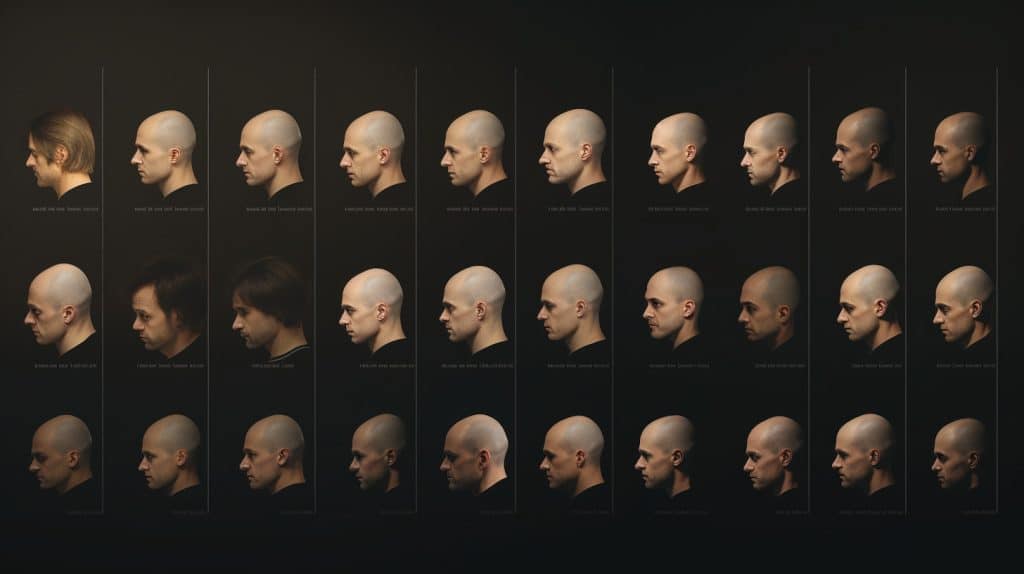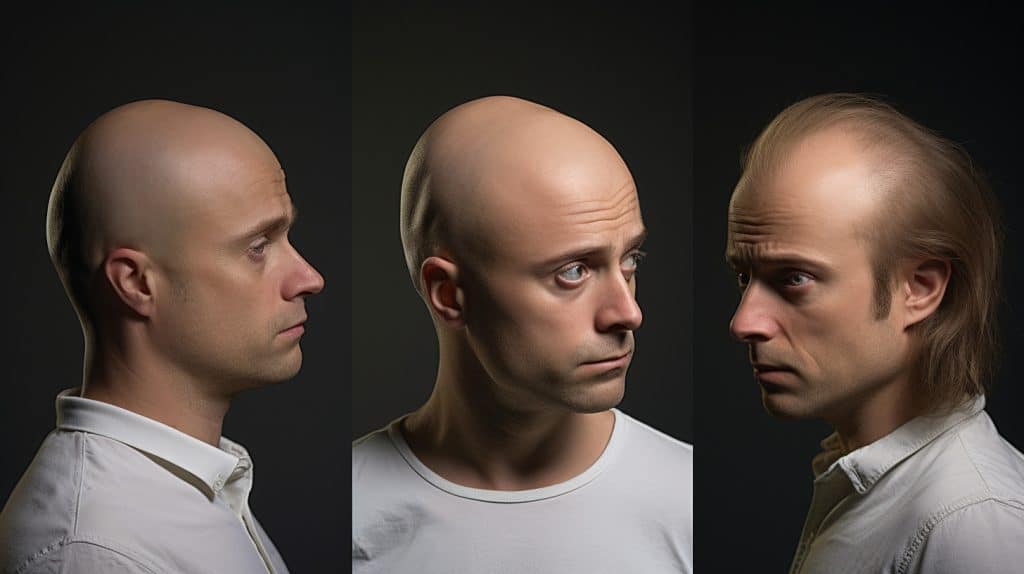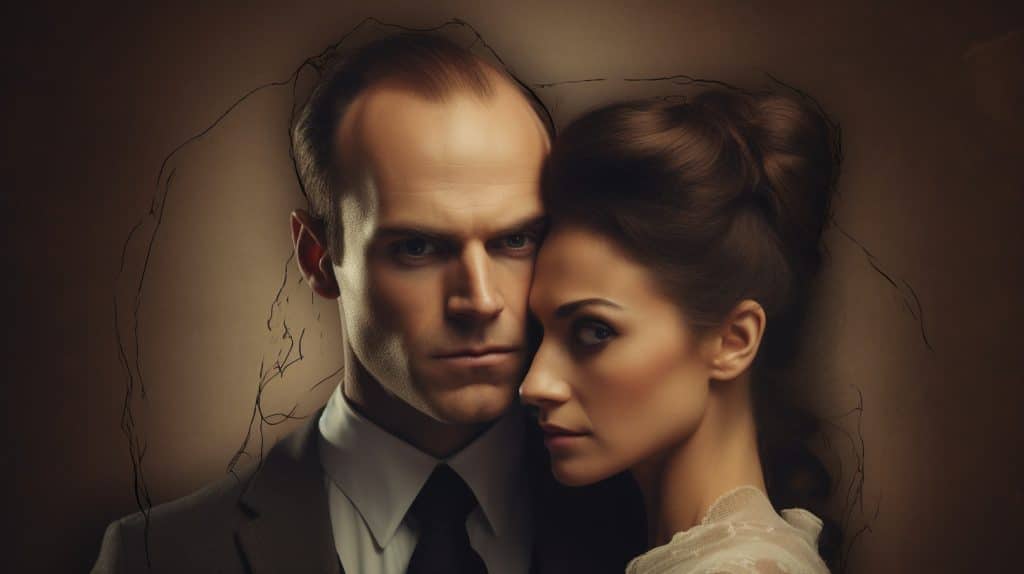Hair Loss Stages:
Have you ever looked in the mirror and noticed a few extra hairs left behind? It's a common occurrence that we all experience from time to time. But what if those hairs keep disappearing, day after day, until you start to see noticeable thinning or bald patches? That's when it's natural to wonder: is this something I should be worried about?

Hair loss can be a distressing experience, affecting both our appearance and our self-confidence. But here's the good news: understanding the stages of hair loss can help us navigate this journey with knowledge and confidence.
In this article, we'll delve into the science behind hair loss and explore the early signs that are often overlooked. We'll decode the different stages of hair loss, so you can better understand where you may fall on this spectrum. And most importantly, we'll discuss proven strategies for combatting each stage of hair loss.
Whether you're just starting to notice some shedding or have been dealing with thinning hair for years, this article has something for everyone.
Key Takeaways
– Understanding the stages of hair loss can help navigate the journey with knowledge and confidence.
– Male pattern baldness can be classified using the Norwood scale.
– Treatment options like finasteride and minoxidil can help slow down or reverse hair loss.
– Recognizing the stages of hair loss can determine when to take action.
While hair loss usually affects the scalp, some conditions can cause hair loss on other areas of the body. Alopecia areata is a disease that can cause hair loss anywhere on the body where hair grows. People who have alopecia areata often have hair loss on their scalp, but they can also lose part (or all) of their:
https://www.aad.org/public/diseases/hair-loss/insider/begin
Understanding the Science Behind Hair Loss
Do you want to understand the science behind hair loss?
Let's delve into how and why it happens, from genetic factors to stress-induced conditions like telogen effluvium.

Hair loss can occur in different stages, and understanding these stages can help us identify the signs and symptoms of male pattern baldness.
One commonly used tool for classifying male pattern baldness is the Norwood scale. This scale helps determine the stage of hair loss by evaluating patterns such as receding hairline or thinning on the crown.
In early stages, you may notice a slight recession at the temples or a widening part line. As the condition progresses, hair loss becomes more noticeable and may result in complete baldness on top while leaving hair at the sides and back.
If you suspect that you are experiencing male pattern baldness at any stage, it's important to seek treatment early on. There are various options available to help slow down or even reverse hair loss. Medications like finasteride and minoxidil have been proven effective in promoting hair growth and preventing further loss.
By understanding the stages of male pattern balding, we can take initiative-taking steps towards identifying it early and seeking appropriate treatment. Remember, if you're concerned about your hair loss, don't hesitate to consult with a healthcare professional who can provide guidance tailored to your specific needs.
The Shocking Early Signs of Hair Loss You Might Be Ignoring
Neglecting the subtle indications of your hair's vanishing act? Brace yourself for the shocking early signs you might be ignoring! Hair loss can sneak up on us, gradually thinning our locks and changing our appearance.
But how do we know when it's time to worry? Understanding the stages of hair loss is crucial in recognizing these early indicators.
To paint a clearer picture, let's imagine a table with three columns and five rows. In the first column, we have “Stage of Hair Loss.” The second column lists “Description,” while the third column provides “Action Needed.”
| Stage of Hair Loss | Description | Action Needed |
|---|---|---|
| Stage 1 | Widening part or less fullness in ponytail (for women) | Monitor hair loss |
| Stage 2 | Gradual thinning or slow-growing bald spot | Seek medical advice |
| Stage 3 | Receding hairline or widening part | Consider treatment options |
| Stage 4 | Thinner ponytail | Consult with a specialist |
| Stage 5 | Noticeable baldness | Explore advanced treatment options |
Recognizing these stages can help determine whether it's time to take action. From male pattern baldness to telogen effluvium, understanding the types of hair loss and their respective treatments is essential. Remember, our hair goes through a natural growth cycle, so occasional shedding is normal. However, if you notice excessive or sudden hair loss, it may be worth seeking professional advice.
So don't turn a blind eye to those early warning signs! Stay vigilant and proactive when it comes to your precious strands. Knowledge is power when it comes to maintaining healthy hair follicles and promoting optimal hair growth.
Decoding the Different Stages of Hair Loss
Pay attention to the subtle changes in your hair's appearance and take a closer look at the different stages of hair loss. It's like deciphering a secret code that only your hair follicles know. Understanding these stages can help you determine if it's time to worry or if it's just a normal part of the hair growth cycle.

The first stage is the anagen phase, also known as the growing season. This is when your hair follicles are actively producing new hairs and can last anywhere from 3 to 7 years. During this phase, you might notice thick and healthy hair.
Next comes the catagen phase, which is like a transition period. Hair growth slows down, and your strands become weaker. This phase lasts for about 2 weeks.
Then we have the telogen phase, also known as the resting phase. About 10-15% of your hair follicles are in this stage at any given time. It's completely normal for hairs in this phase to shed, resulting in about 100 strands lost per day.
Lastly, there's the exogen phase where old hairs fall out completely before new ones start growing again.
So when should you start worrying? If you notice excessive shedding or if your thinning becomes noticeable, it might be time to seek medical advice.
Remember, everyone experiences some degree of hair loss throughout their lives. But understanding these different stages can give you peace of mind and help you decide what your own hair is trying to tell you.
Effective treatments for some types of hair loss are available. You might be able to reverse hair loss, or at least slow it. With some conditions, such as patchy hair loss (alopecia areata), hair may regrow without treatment within a year. Treatments for hair loss include medications and surgery.
https://www.mayoclinic.org/diseases-conditions/hair-loss/diagnosis-treatment/drc-20372932
Proven Strategies for Combatting Each Stage of Hair Loss
Lucky you! You've unlocked the secret strategies for battling those sneaky stages of hair departure. When it comes to hair loss, timing is everything. Knowing when to worry can make all the difference in finding effective solutions. So, let's dive into the proven strategies for combatting each stage of hair loss.
First up, we have male pattern baldness, a stage that often starts with a receding hairline and progresses to a noticeable thinning on top. The good news is that there are natural ways to slow down or even reverse this process.

One strategy is using minoxidil, an FDA-approved medication that promotes hair growth. Another option is finasteride, which inhibits the hormone responsible for shrinking hair follicles.
Next, we move on to other stages of hair loss, whether due to illness, stress, or simply aging. In these cases, it's important to focus on overall scalp health and nourishment. Regularly massaging your scalp with essential oils like rosemary or peppermint can stimulate blood flow and promote healthy hair growth. Additionally, incorporating a balanced diet rich in vitamins and minerals can provide the necessary nutrients your locks need.
Remember, not all hope is lost when it comes to hair loss stages! By understanding the different types and implementing these proven strategies tailored to each stage of hair loss, you'll be well-equipped in your battle against those elusive strands. So don't fret – take action and reclaim your crowning glory!
Future Trends: Exciting Advances in Hair Loss Treatment
Get ready to be amazed by the exciting advances in hair loss treatment that are shaping the future of regaining your luscious locks! As someone who's experienced hair loss myself, I understand how distressing it can be to watch your once-thick mane thinning out. But fear not, because the future looks promising for those of us concerned about our receding hairlines.
One of the most anticipated trends in hair loss treatment is the development of drugs specifically targeted towards autoimmune conditions and genetic issues. This means that individuals with conditions like alopecia areata or hereditary pattern baldness may soon have more effective options for regrowing their hair.
But that's not all – direct-to-consumer companies are also stepping up their game. Take Muesly, for example. They've recently launched oral minoxidil pills for hair growth, providing a convenient alternative to topical treatments like Rogaine.
Scalp health is another area receiving increased attention in the world of hair care. Companies such as Unilever, Virtue Labs, and Act+Acre are developing new products aimed at promoting scalp health and preventing hair loss from occurring in the first place.
With these exciting advancements on the horizon, there is hope for anyone experiencing hair loss at any stage. Whether you're just starting to notice a few extra hairs on your brush or you're already sporting a shiny bald head, it's never too early or too late to take action.
Exciting advances in hair loss treatment are just around the corner!

So next time you catch a glimpse of your receding hairline or find yourself shedding more than usual, don't panic! Remember that most hair loss is nothing to fret about. It's just a natural part of life.
But if you're really concerned or want to rock that luscious mane again, see a GP who can guide you in the right direction.
And hey, if all else fails and your head ends up as smooth as a baby's bottom, remember that bald is beautiful too! Confidence is key, my friends. So, embrace your inner Vin Diesel or Dwayne ‘The Rock' Johnson and show off that shiny dome with pride!
Now go forth and conquer those follicular challenges with humor and grace. Because at the end of the day, it's not about how much hair we have on our heads; it's about how we carry ourselves and laugh in the face of adversity.
Stay fabulous and keep shining (bald or not)!
FAQs
How long does the hair loss phase last?
The duration of hair loss phases can vary greatly from person to person, and are largely dependent on the individual's genetics, overall health, and lifestyle. Understanding the “hair loss stages” can help you to anticipate what to expect.
In the early stage of male pattern baldness, hair loss can progress slowly over several years, or it can be relatively quick. Similarly, stage 2 hair loss in females may also vary in duration. It's important to consult with a healthcare professional or a dermatologist to understand your specific situation.
Is Stage 3 hair loss reversible?
Stage 3 hair loss, whether male or female, generally signifies a more advanced stage of hair loss. For males, this stage of hair loss is often a pivotal point in the progression of male pattern baldness symptoms. For females, stage 3 hair loss can be quite distressing.
While this stage is typically more difficult to reverse naturally, it's not impossible. Many individuals have seen some success with treatments such as topically applied minoxidil, low-level laser therapy, and natural methods focused on diet and lifestyle changes. Understanding the specific “hair loss stages” can help guide these treatment approaches.
Which stage of hair loss is treatable?
All stages of hair loss, from the early stages of male pattern baldness to stage 2 or 3 hair loss in females, are potentially treatable to some degree. The key is early detection and intervention. Treatments range from over-the-counter topical treatments to prescription medications, surgical procedures, and natural methods on how to reverse male pattern baldness naturally.
It's important to remember that while these treatments can help slow or even reverse hair loss, they work best when started at the first signs of hair loss. Understanding the different types of male pattern baldness and the “hair loss stages” can assist in developing an effective treatment plan.


